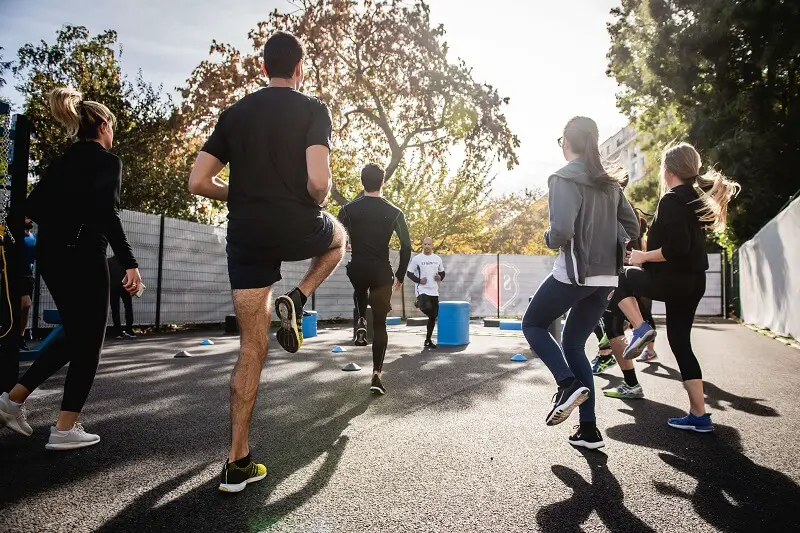Functional fitness has gained popularity in recent years as people seek to improve their overall health and performance in daily activities. Unlike traditional strength training, which often focuses on isolated muscle groups, functional fitness emphasizes movements that mimic real-life activities. By incorporating exercises that target multiple muscle groups and engage stabilizing muscles, functional fitness helps improve balance, flexibility, and coordination, making everyday tasks easier and reducing the risk of injury. In this article, we’ll explore a variety of functional fitness exercises designed to enhance functional movement patterns and improve overall fitness levels.
Squats: Building Lower Body Strength and Mobility
Squats are one of the most effective functional exercises for building lower body strength and mobility. They target the quadriceps, hamstrings, glutes, and core muscles, which are essential for activities like standing up from a chair, lifting objects, and climbing stairs. To perform a squat, stand with your feet shoulder-width apart, lower your hips back and down as if sitting into an imaginary chair, keeping your chest upright and your knees tracking over your toes. Lower down until your thighs are parallel to the ground, then press through your heels to return to the starting position. Start with bodyweight squats and gradually progress to weighted variations as you build strength and confidence.
Deadlifts: Strengthening the Posterior Chain
Deadlifts are another foundational functional exercise that targets the posterior chain muscles, including the hamstrings, glutes, lower back, and core. They simulate the movement pattern of lifting objects from the ground, making them highly transferable to real-life activities like picking up groceries or lifting furniture. To perform a deadlift, stand with your feet hip-width apart, grip a barbell or dumbbells with an overhand grip, hinge at the hips, and lower the weight towards the ground while keeping your back flat and chest lifted. Engage your core and drive through your heels to return to a standing position, squeezing your glutes at the top of the movement. Start with light weights and focus on maintaining proper form throughout the exercise.
Push-Ups: Building Upper Body Strength and Stability
Push-ups are a classic functional exercise that targets the chest, shoulders, triceps, and core muscles, improving upper body strength and stability. They mimic the pushing motion used in activities like pushing open doors, pushing yourself up from the ground, or pushing objects away from your body. To perform a push-up, start in a plank position with your hands shoulder-width apart, wrists aligned under your shoulders, and body in a straight line from head to heels. Lower your body towards the ground by bending your elbows, keeping them close to your sides, until your chest nearly touches the floor. Push through your palms to extend your arms and return to the starting position. Modify the exercise by performing push-ups on your knees or against a wall if needed, gradually increasing difficulty as you get stronger.
Planks: Strengthening the Core and Improving Stability
Planks are a simple yet effective exercise for strengthening the core muscles and improving overall stability. They help develop the muscles of the abdomen, lower back, and shoulders, which are essential for maintaining proper posture and stability during everyday activities. To perform a plank, start in a push-up position with your hands shoulder-width apart, wrists aligned under your shoulders, and body in a straight line from head to heels. Engage your core muscles and hold this position for as long as possible, making sure to keep your hips level and avoid sagging or arching your back. Challenge yourself by adding variations such as side planks, plank shoulder taps, or plank leg lifts to target different muscle groups and increase difficulty.
Lunges: Enhancing Lower Body Strength and Balance
Lunges are a functional exercise that targets the quadriceps, hamstrings, glutes, and calf muscles while improving balance and coordination. They simulate the movement pattern of walking or climbing stairs, making them highly relevant to real-life activities. To perform a lunge, stand with your feet together, step forward with one foot, and lower your body towards the ground until both knees are bent at a 90-degree angle, making sure your front knee stays aligned with your ankle. Push through your front heel to return to the starting position, then repeat on the other side. You can also perform reverse lunges, walking lunges, or lateral lunges to target different muscle groups and add variety to your workout routine.
In conclusion, functional fitness exercises are essential for improving overall strength, mobility, and stability, making everyday activities easier and reducing the risk of injury. By incorporating movements that mimic real-life activities into your workout routine, you can build a strong and resilient body that performs optimally in any situation. Whether you’re squatting to pick up a heavy object, pushing open a door, or climbing stairs, functional fitness exercises help prepare your body for the demands of daily life. Start with these foundational exercises and gradually progress to more advanced variations as you build strength, confidence, and proficiency. With consistency and dedication, you can reap the benefits of functional fitness and enjoy improved health and vitality for years to come.
